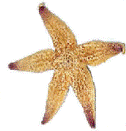Department of Chemistry
Date of this Version
2008
Abstract
The asteroidal sperm-activating peptides (asterosaps) from the egg jelly bind to their sperm receptor, a membrane-bound guanylate cyclase, on the tail to activate sperm in sea stars. Asterosaps are produced as single peptides and then cleaved into shorter peptides. Sperm activation is followed by the acrosome reaction, which is subfamily specific. In order to investigate the molecular details of the asterosap-receptor interaction, corresponding cDNAs have been cloned, sequenced and analysed from the Asteriinae subfamily including Asterias amurensis, A. rubens, A. jorbesi and Aphelasterias japonica, as well as Distolasterias nipon from the Coscinasteriinae subfamily. Averages of 29% and 86% identity were found from the deduced amino acid sequences in asterosap and its receptor extracellular domains, respectively, across all species examined. The phylogenic tree topology for asterosap and its receptor was similar to that of the mitochondrial cytochrome c oxidase subunit I. In spite of a certain homology, the amino acid sequences exhibited speciation. Conservation was found in the asterosap residues involved in disulphide bonding and proteinase-cleaving sites. Conversely, similarities were detected between potential asterosap-binding sites and the structure of the atrial natriuretic peptide receptor. Although the sperm-activating peptide and its receptor share certain common sequences, they may serve as barriers that ensure speciation in the sea star A. amurensis and closely related species.


Comments
Published in Zygote 16 (August 2008), pp. 229-237. Doi:10.1017/S0967199408004759. Copyright © 2008 Cambridge University Press. Used by Permission.